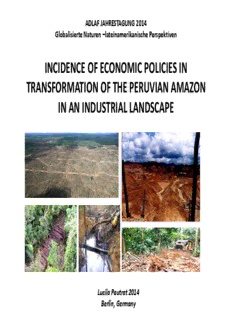
Economic Policy in the Peruvian Amazonian PDF
Preview Economic Policy in the Peruvian Amazonian
ADLAF JAHRESTAGUNG 2014 Globalisierte Naturen –lateinamerikanische Perspektiven INCIDENCE OF ECONOMIC POLICIES IN TRANSFORMATION OF THE PERUVIAN AMAZON IN AN INDUSTRIAL LANDSCAPE Lucila Pautrat 2014 Berlín, Germany THE CONTEXT: PERÚ • Economic Growth (June 2014): 4 % of GDP • Main Activities: Oil & Metal mining • 30 % of the population live in poverty and 12 % in extreme poverty • One of the 8 mega-biodiverse countries in the world • 70 millions hectares of tropical forests in the Amazon Basin • 3.5 million inhabitants in the Amazon (13% of the country population) • 1,509 indigenous communities THE AMAZON BASIN High global importance. 7 millions km2 (40% South America’s area) The largest tropical rainforest on the planet, and the most important river system in terms of flow Provides livelihood to 30 million people in 8 countries, including more than 350 ethnic groups and indigenous peoples Food and energy for more than 60% of the Amazon population The main global system of carbon Environmental goods and services of sequestration, and a megabiodiversity economic, industrial, commercial, social, areas. Regulate ecological and large- cultural, ethical and aesthetic value scale climate processes. OTHER CAUSES: •Increase in global demand for natural resources and energy sources by industrialized countries and emerging economies • Weakness of environmental regulation and social standards • Fluctuations of international prices of metals and hydrocarbons • Consolidation of a primary exports-based market economy, •Inefficiency of public administration to promote equitable and sustainable development at regional and local levels; •Financial speculation and money laundering from narcotraffic and other illicit activities •Influence peddling from business groups and corruption regarding the economic occupation of the Amazon territory MACROECONOMIC AND INSTITUTIONAL REFORMS IMPLEMENTED BETWEEN 1990 – 2000: • Sought to pacify the country, stabilize the economy, build trust and promote a favorable climate for investment • The Peruvian State adhered to the guidelines of discipline and fiscal reforms of the Washington Consensus Institutional Reforms: • Adoption of a new Political Constitution of Peru (1993). • The creation of the National Tax Administration - SUNAT, and reform the tax system • The reform of the Comptroller General of the Republic, the Constitutional Tribunal, the Judiciary, among others. International financial institutions (IMF, WB and IDB) prioritized lines of credit and assistance in infrastructure and energy projects. From small-scale concentrated deforestation Slash & burn Illegal logging Soil and slopes erosion, To Large-scale industrial deforestation FUEL GAS PROJECT DEFORESTATION 2005: 7’171,554 ha 2014: Unknown -Informal settlement -Illegal crops of coca leaves - Illegal gold mining - Oil and energy infrastructure PROJECTED INVESTMENT POLICIES: 2012 - 2016 PERÚ: ECONOMIC GROWTH (% GDP) - 2014
Description: